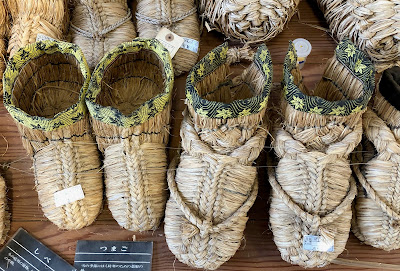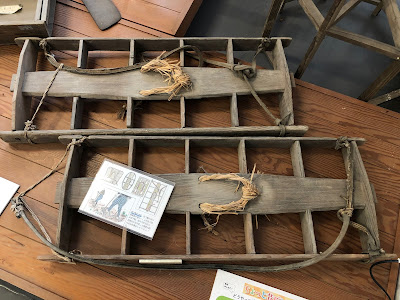--Susan, every other Sunday
Some time ago, I visited Michinoku Folklore Village in Iwate, a prefecture in the northern Tohoku region of Honshu (Japan's largest island).
 |
| Michinoku Folklore Village in the snow |
The folklore village--one of many such "living history" parks in Japan--consists of historic houses and other structures (like mills, local shrines, and storehouses) that have been moved from their original locations to a protected park where visitors can come to learn about life in Japan's late medieval and early modern (mostly Edo and Meiji) periods.
 |
| The interior of a 19th century merchant home |
In addition to the houses themselves--all of which are open for visitors to walk through--Michinoku Folklore Village has a converted 19th century schoolhouse that now serves as home to displays of farming artifacts that show how Iwate's villagers lived from the 17th-20th centuries.
 |
| Farming life in the pre-modern era |
I'm a sucker for historical artifacts in any form, and for folklore villages in particular--especially when a visit involves a brisk walk through the snow--but one display at Michinoku captured my attention more than usual, mainly because I'd never seen such an elaborate display of antique shoes.
 |
| O-waraji (literally "honorable sandals") |
The display included not only traditional o-waraji (sandals), but heavy work shoes
 |
| heavy-duty work shoes |
The bands of colorful fabric around the tops of the work shoes were designed to prevent the edges from chafing ankles, as well as to prevent the shoes themselves from fraying.
There were snow boots:
 |
| 16th century Uggs |
and even wooden "mud shoes" used to prevent the wearer's feet from sinking irretrievably deep into the mud that forms in paddy fields (and low-lying village paths when the spring thaw comes).
 |
| Complete with handles, so you can pull them out of the mud when they get stuck. |
Most shoes were woven by women, using leftover rice straw from the annual harvest. The sturdiness and functionality of these items never ceases to amaze me--and while I'd seen most of these styles in different places from time to time, I had never seen them all in a single place.
The exhibit also included some of the wooden loom forms used for weaving various kinds of shoes:
 |
| Shoe Looms |
as well as a larger loom used for weaving straw "cloth" that was used for making rain gear.
 |
| Weaving straw |
I read a lot of history books, and learn a lot through words and print, but displays like this have a way of collapsing time and making history both real and far more personal. It's one thing to know that people wore hand-woven shoes made from straw or grass, but another to see not only the shoes they wore (or even modern replicas, which many of the ones on display in Iwate clearly are) but the actual, handmade looms and other tools they used to make them.
In the mountains, good shoes often mean the difference between life and death. That was particularly true before the advent of modern life: in a medieval mountain village, if your feet got frozen, or injured, you could not work, or walk, or do the things you need to do to live. In the modern world, it's easy for many of us to take shoes for granted, but it wasn't that long ago that shoes like the ones in this display were still the norm (and, in some places, it's still true today).
The craftsmanship of Japanese woven shoes is impressive, even by modern standards--and while I'm not in a hurry to climb any mountains wearing them, I'm absolutely impressed by the many people who did just that (and more) in years gone by.
The museum and the village had far more on display than "merely" shoes--in fact, the sandals took up only one small corner of one floor--but they impressed me enough that I thought I'd "shoe" them off to you as well.
It's possible to buy modern reproductions of traditional sandals in many places across Japan. So, tell me: would you be interested in walking a mile (or two) in a pair of rice straw shoes?















What a wonderful idea to have a whole historic village that you can visit. As to the rice stalk shoes, I think I'll pass!
ReplyDeleteDearest Susan, By now I hope you have seen the photo I sent you of the Chinese straw shoes that my father brought home in 1946. I wore them as part of my Halloween costume when I was about five. I have a grown up pair too. I don’t remember them hurting me as a kid, but Michael is right. No thickness of socks, could make them bearable. At least not once the straw has dried out.
ReplyDelete